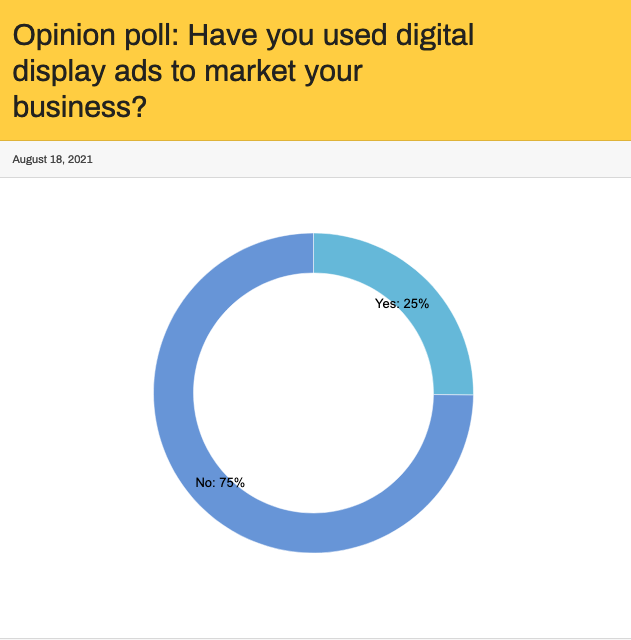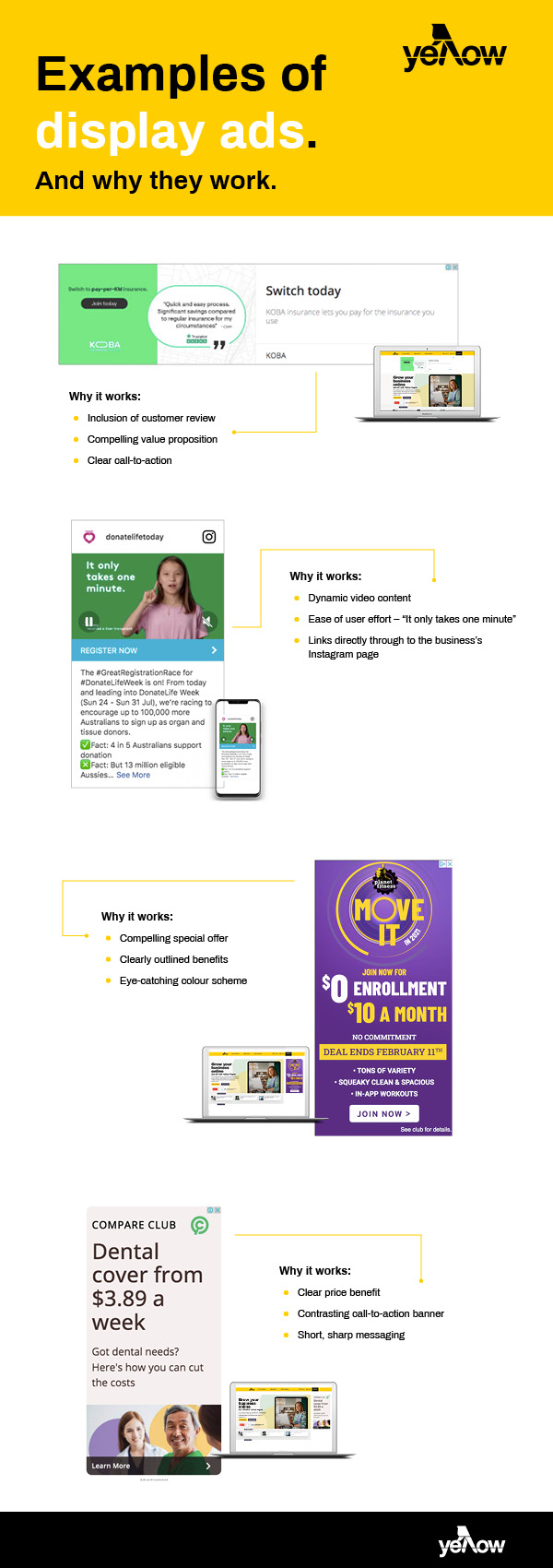Digital ads, including banner ads, social media ads, and google display ads, are crucial tools for businesses of all sizes. These ads offer small businesses a way to reach a brand new audience. Digital ads aren’t just for large enterprises with big budgets, they can be highly effective and affordable for small businesses, thanks to targeted approaches that reach specific demographics, interests, and behaviours.
Platforms like google ads and social media networks provide flexible options to fit various budgets and marketing goals. Whether promoting a new product, announcing a special offer, or building brand awareness, digital ads can be tailored to meet the unique needs of small businesses.
In 2021, we asked businesses whether or not they used digital display ads to market their business, only 25% of people said yes while 75% of people said they had never used display ads.

Here’s how display ads work and the benefits of this visual online advertising channel.
What is digital display advertising and how does it work?
Display ads are static or dynamic (animated) boxes you see on websites, apps, videos, etc. They can show up at the top of web pages as banner ads, or as larger text billboards, smaller boxes, or as side columns. Unlike text-based ads on search engines, display advertising typically includes visual elements like images, audio and/or video.
The vast majority of display ads are set up via Google Ads and shared across the Google Display Network, which includes 35 million websites and apps, as well as YouTube and Gmail.
Like pay per click (PPC) text ads, with display advertising you choose keywords that you want to associate with your ads and set a budget for those keywords (known as ‘keyword bidding’). You can also target users and choose ad placements based on factors such as:
- User interests
- Specific website placements
- Demographics e.g. age, gender, location
- Whether a person has visited your website or interacted with your business online before
Your chosen keywords and targeting preferences determine where your ads are shown and who they’re shown to.
Today, display campaigns use what’s known as ‘responsive display ads’. Responsive display ads automatically adjust their size, appearance and format to fit the available ad space across any device or screen size. All you need to do is upload various assets (images, headlines, logos, videos and descriptions) and Google Ads automatically chooses the optimal combination of assets to show in ads across websites, apps, YouTube and Gmail.
Why are display ads good for small business?
Widespread adoption:
Approximately 65% of small to mid-sized businesses have a pay-per-click (PPC) campaign, demonstrating the popularity of digital ads among smaller enterprises
Social media marketing:
33% of small businesses focus most of their digital marketing efforts on social media, leveraging platforms like Facebook and Instagram to engage with their audience
50% of B2B marketers find social media to be the most effective digital marketing strategy, highlighting its importance even in the business-to-business sector
Budget allocation:
On average, small businesses spend about $534 per month on digital advertising. This figure is expected to grow as more small businesses recognize the value of digital ads
A survey revealed that 93% of small businesses plan to increase their spending on digital advertising in the coming years, underscoring their commitment to this marketing approach
High ROI:
Digital ads offer a substantial return on investment (ROI). For every dollar spent on digital advertising, businesses can earn about $2 back. This 200% ROI makes digital ads a highly attractive option for small businesses looking to maximise their marketing budgets
Digital ads are not only feasible but also highly effective for small businesses. With strategic planning and proper budget allocation, small businesses can leverage digital advertising to compete with larger companies and achieve significant marketing success.
The three cost models for display ads
- Cost per click (CPC): Under this model, you pay every time a person clicks on your ad. This is useful if you want to make sure people are performing an action before you pay.
- Cost per thousand impressions (CPM): With this set-up, you pay per thousand views of your ad. You might prefer this option if volume of views (awareness) is more important than click-throughs.
- Cost per acquisition/lead (CPA/CPL): With CPA ads, you only pay for clicks when visitors complete a specific action after clicking on your ad, such as purchasing a product or signing up for a newsletter. This is a good option if you want to make sure a specific action is taken before you pay.
The benefits of display ads.
No matter where you’re advertising your business, there are three key aims: grabbing people’s attention, maximising the number of relevant people who see your ad and driving those people to take an action, such as clicking through to your website or making an inquiry.
Digital display advertising is particularly good at achieving these three things because you can continually refine your messaging, placement and targeting as you go, and adjust your strategy so you’re only spending money on the ads that are getting results.
When it comes to results, the average return on investment for Google Ads (including display ads) is 200%, which means businesses earn an average of $2 for every $1 spent on advertising. In other words, display advertising pays for itself – twice over, in fact – in the form of revenue for your business.
To put it succinctly, digital display advertising helps do the following:
- Increase awareness about your brand
- Get you in front of your target market
- Reconnect with people who have visited your website or connected with your business online in the past (also known as ‘retargeting’)
- Drive people to take action.
Ultimately, display ads help grow your potential customer base and encourage people to move from consideration to conversion (i.e. paying for your products or services).
RELATED: eBook: Digital display advertising for small businesses.
The drawbacks of display ads for small businesses.
While digital display ads offer numerous benefits for small businesses, they also present several challenges:
Budget constraints: Small businesses often operate with limited marketing budgets, making it difficult to compete with larger companies that have more resources to invest in high-quality ad creatives and extensive campaigns.
Ad fatigue: Over-exposure to the same ads can lead to ad fatigue, where potential customers start ignoring the ads. Small businesses need to continually refresh their ad creatives to maintain engagement, which can be resource intensive.
Targeting precision: Achieving precise targeting can be challenging without access to advanced analytics and tools. Small businesses may struggle to reach the right audience effectively, leading to wasted ad spend.
Competition and noise: The digital advertising space is crowded, making it hard for small businesses to stand out among a sea of competitors. This competition can drive up the cost per click or cost per impression, reducing the overall return on investment.
Technical expertise: Setting up and managing digital ad campaigns requires a certain level of technical knowledge. Small businesses may lack the expertise needed to optimise their ads for the best performance.
Measurable results: While digital ads provide measurable results, small businesses may find it difficult to interpret the data and adjust their strategies accordingly. This can result in less effective campaigns and a lower return on investment.
Ad blockers: The use of ad blockers by consumers can reduce the visibility of display ads, impacting their effectiveness. Small businesses need to find ways to create ads that are engaging enough to bypass these blockers or explore alternative advertising methods.
Addressing these pain points requires careful planning, continuous optimization, and sometimes seeking external expertise to ensure digital display ads are effective and provide a good return on investment for small businesses.
Display ad examples.
So, what makes an effective banner ad? Aside from choosing targeting that is relevant to your business and your customer base, the best display ads capture attention with a compelling message, a clear call-to-action and a visually engaging design.
Here are some examples of effective display ads and what makes them work:

How to get started with digital display ads.
With the right approach, digital display advertising is an effective way to reach new customers and help grow your business – but it does take some digital marketing know-how.
Yellow Pages’ Digital Display team delivers digital display ads to thousands of Aussie businesses. Our hands-on experience, teamed with the latest machine learning, means our ads deliver exceptional results that cut through the competition. Find out more about how we can help.
